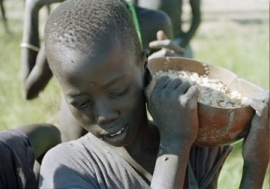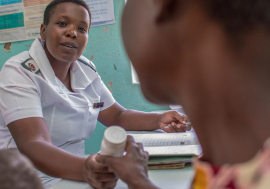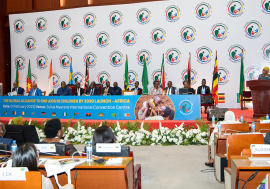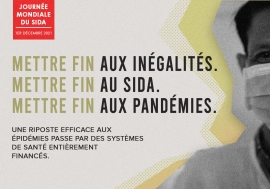Toll mounts in global AIDS pandemic
Toll mounts in global AIDS pandemic
The HIV/AIDS pandemic continued its deadly assault on sub-Saharan Africa in 2003, taking an estimated 2.3 million lives, infecting an additional 3 million people, and continuing its relentless spread in all but a very few countries. With education and prevention programmes starved for funds, access to medications limited to the very rich or the very fortunate and victimization of the infected all too common, Africa and the international community failed to halt the spread of the disease, or ease the suffering and economic and social devastation it has wrought.The grim findings are contained in an epidemic update released on 25 November by the Joint UN Programme on HIV/AIDS (UNAIDS). The report confirms that Africa remains the epicentre of the global crisis, accounting for almost 80 per cent of the 3 million fatalities worldwide and over 60 per cent of the 5 million new infections.Despite increased spending on HIV/AIDS programmes and improved responses by many governments, noted UNAIDS Executive Director Peter Piot, “our current global efforts remain entirely inadequate for an epidemic that is continuing to spiral out of control.” The rapid spread of the human immunodeficiency virus that causes AIDS in Eastern Europe, South and Central Asia and other areas with low infection rates, he said, meant that governments in those regions “can either act now” to contain the disease “or pay later — as Africa is now having to pay” — in lives and lost development.A 9-year-old South African prays before taking her anti-retroviral medicines.Photo: © Getty Images / Per-Anders Pettersson African women hardest hit Although adult infection rates vary widely in Africa, from less than 1 per cent in Mauritania to nearly 40 per cent in Botswana and Swaziland, Southern Africa remains by far the worst affected. The region includes just 2 per cent of the world's population but accounts for fully 30 per cent of all HIV infections. Women aged 15-24 now comprise the majority of new infections in Africa, and are more than twice as likely to contract the virus as young men.The news is better in Uganda, where years of aggressive education and prevention programmes saw infection rates in the capital, Kampala, drop to 8 per cent, down from 30 per cent a decade ago. A similar approach helped Senegal keep its infection rate stable at about 1 per cent, although rising rates among commercial sex workers in urban areas leave no grounds for complacency. There are positive developments in Southern Africa too, with South Africa set to join Botswana in providing treatment for HIV and AIDS through the public health system — including anti-retroviral drugs (ARVs) that attack the virus itself. Infection rates in Zambia and Malawi appear to have levelled off — although at alarmingly high levels.New tools lower estimatesBut UNAIDS cautions that the stabilization of infection rates in Southern Africa in particular is misleading — reflecting not a reduction of new infections, but an increase in deaths. In Zambia, for example, the number of new infections was matched by the number of AIDS fatalities in 2003, keeping statistics on infection rates steady as older victims died.The statistical problem is exacerbated this year by changes in the way UNAIDS and the World Health Organization (WHO) calculate figures on the HIV/AIDS pandemic. Improved data collection and analytical tools have led these organizations to lower their estimates of infection rates and deaths in 2003 compared to those published in previous years. Under the new system, the total number of people living with HIV/AIDS, calculated to be 40 million, actually reflects the midpoint between the lowest estimate of people infected, 34 million, and the highest, 46 million. Similarly, the number of African fatalities for 2003, set at 2.3 million, actually represents estimates of between 2.2 million and 2.4 million. The range is much narrower for deaths because of the greater availability and reliability of mortality records.These changes give the appearance that the global epidemic stabilized or even improved over the past year. Regrettably, the lower figures reflect only the changes in data collection and analysis. When researchers apply the new methods to previous years, the report emphasizes, they find a steady increase over time in both infection and mortality rates.More than 20 years after the first case of AIDS was diagnosed, “The most devastating social and economic impacts of AIDS are still to come,” cautioned Dr. Piot. Initiatives like WHO's drive to provide 3 million people with ARVs by 2005, combined with expanded education and prevention campaigns, an end to discrimination against people with HIV and much wider use of a simple treatment to prevent mother-to-child infections, he said, would go far to mitigate the worst of those impacts. But to date the world has failed to provide the $10 bn annually that an effective response to the disease would cost. At present rates of infection, the cost of an effective global response to the disease will rise to $15 bn by 2007.HIV/AIDS in Africa and the world (in millions) Global Africa Africa as % of totalTotal HIV infections:4026.666.52003 HIV infections: 53.264.02003 Fatalities:32.376.6Percentage of population infected by HIV1.18.0 ARV treatmentRequiring treatmentReceiving treatmentSub-Saharan Africa:4.1 million50,000In all developing countries:6.0 million300,000Source: UN Africa Recovery from UNAIDS and WHO data.


















